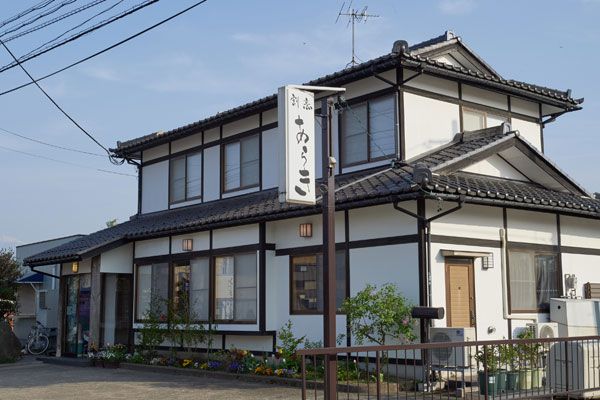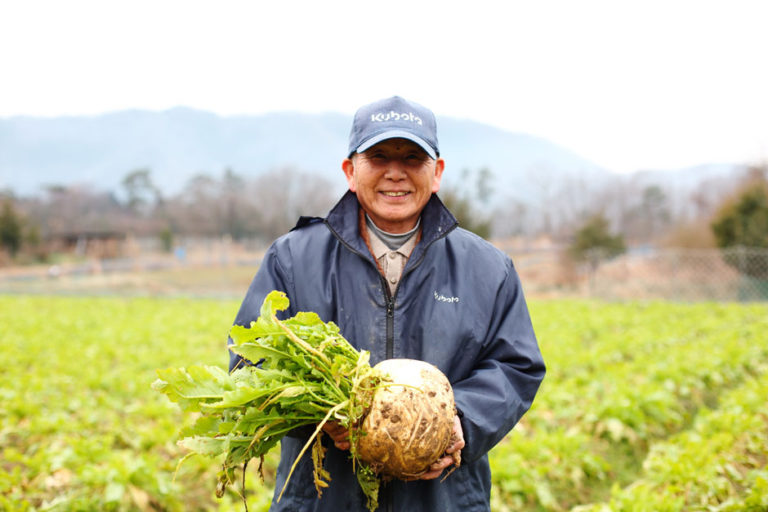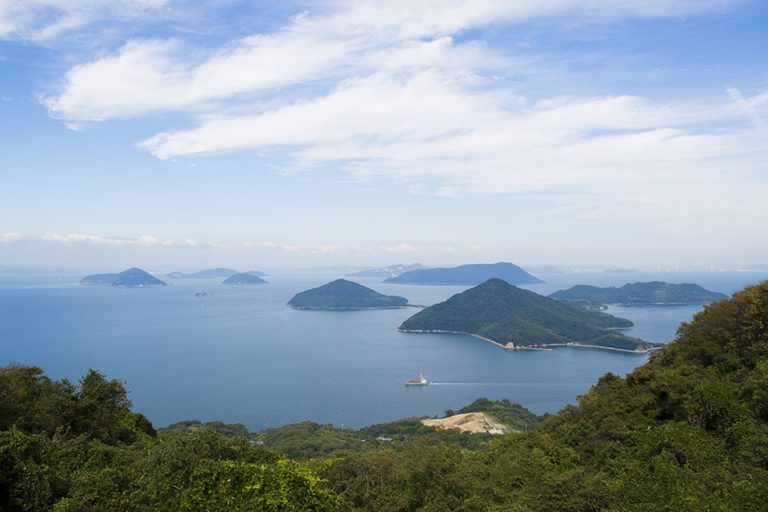Firefly Squid—the Blue Jewels that Emerge from the Depths on Spring Evenings
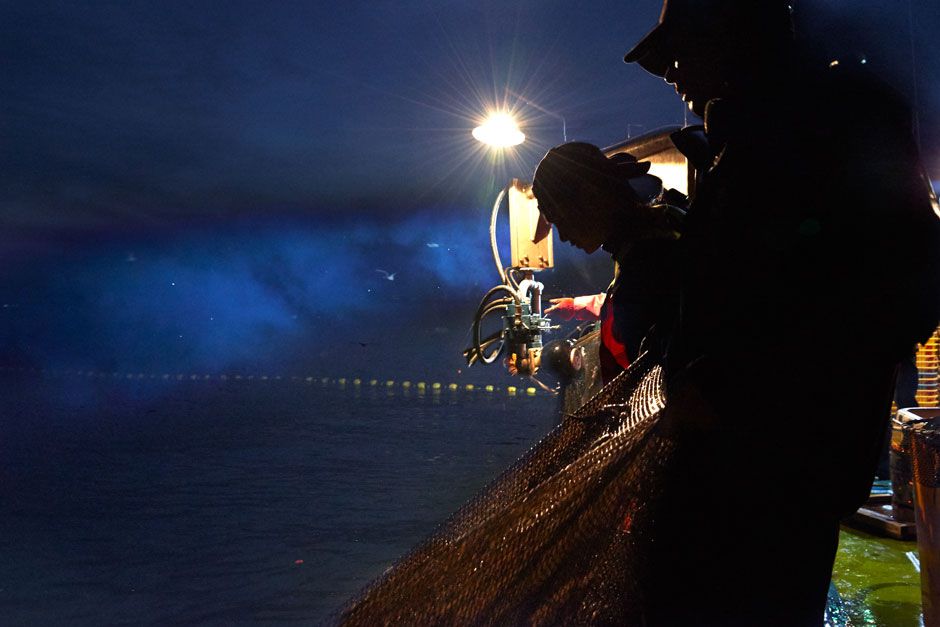
Toyama Bay benefits from a fortuitous combination of sea currents and topography
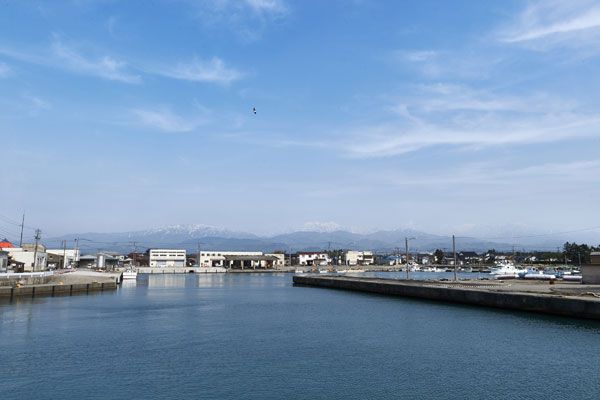
The natural fish pen that is Toyama Bay is the product of the unusual ocean floor topography, which reaches extraordinary depths just a short distance from the coastline. The deepest point in the bay is some 1,200 meters below the surface, and the ocean floor is riddled with ridges and valleys that provide the ideal habitat for a variety of aquatic life.
The nearby Tateyama mountain chain, with peaks well in excess of 3,000 meters, provides fresh water flows that hurtle down vertical descents of up to 4,000 meters, creating strong ocean currents that carry nutrients down to the sea floor and encourage rapid propagation.
Also, the fishing grounds are just a short distance from the port where catches are unloaded, which means that the fish are incredibly fresh, an important selling point at auction. It’s as if nature has contrived to design the perfect fishing environment for our benefit.
The firefly squid ascend to the surface of Toyama Bay and put on a spectacular show
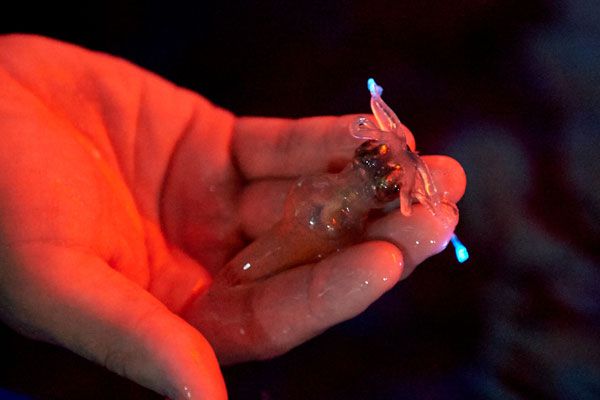
The firefly squid is a leading attraction at Toyama Bay.
While firefly squid are found throughout the Japan Sea area, they normally reside at depths of 200 to 600 meters beneath the water. It is only at Toyama that the firefly squid rise to the surface in large numbers relatively close to the coast, producing a spectacle quite unlike anything else in the world. The sea area stretching from the mouth of the Joganji river in Toyama city down to the fishing port of Uozu, known as Hotaru Ika Gunyu Kaimen in Japanese, has accordingly been declared a designated natural monument by the national government.
The females with fertilized eggs ascend most of the way to the surface to spawn in the springtime. The strong currents of Toyama Bay carry them close to the coastline, often lifting them right to the sea line. The males, meanwhile, take in plenty of nutrients and grow considerably larger, and this also contributes to the excellent flavor. Just another of the wonders of Toyama Bay!
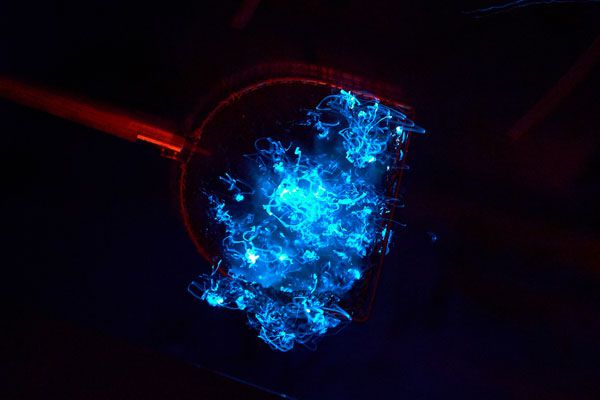
Just like their land-bound cousins, firefly squid have luminous organs that give off a perceptible glow. These luminous organs are found throughout the body, but the two on the ends of the feelers in particular are designed to emit a bright glow when the animal is threatened. The luminous glow is designed to have an intimidating effect on other animals. But the net result for human onlookers is a spectacular blue-white glow that produces a shimmering, almost ethereal effect on the surface of the water. News of the spectacle has spread far and wide, and Toyama Bay swells with domestic and foreign tourists keen to catch a glimpse for themselves.
Namerikawa is first and foremost a fishing port on Toyama Bay known for bountiful firefly squid harvests. But during the firefly squid season, the Hotaru Ika Kaijo Kanko tourist service is also kept busy ferrying tourists out into the bay at night to view the spectacular light show.
The firefly squid are visible only for a short period, from the end of March to early May, so the tourist service only operates at these times. Occasionally the tours have to be cancelled due to rough weather, or when the numbers are too low to be properly visible.
Notwithstanding the vagaries of the natural elements, the opportunity to witness this spectacular of nature is extremely popular. Places on the boats are booked out almost instantaneously, with visitors clamoring to join the ranks of the lucky few to have sailed out into the bay at night to witness something very special.
The beautiful blue-white glow of the firefly squid
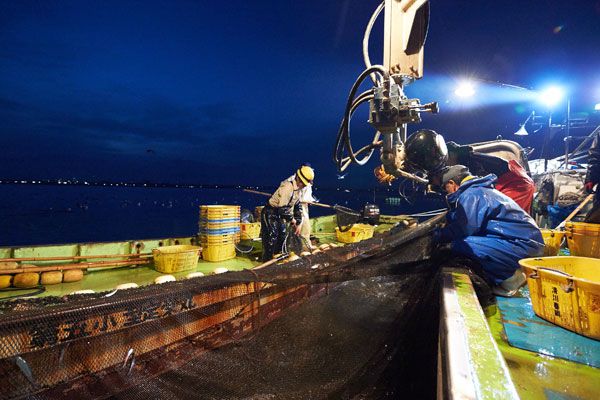
Namerikawa Springtime Fixed Net Fishing Cooperative, as the name implies, catches firefly quid by the fixed net fishing method, continuing a tradition that dates back to the Edo period. The nets, generally made of straw, are cast out in the bay to capture the squid as they make their way towards the shore to spawn.
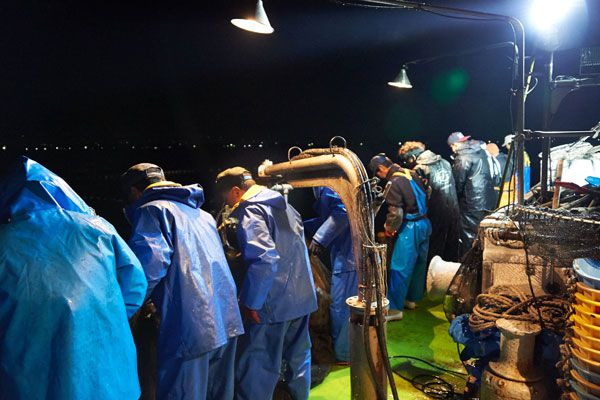
The fishermen of the Namerikawa Springtime Fixed Net Fishing Cooperative use traditional straw nets, which are much gentler on the tiny delicate firefly squid. The straw nets are also recyclable: at the end of each season, they are cast back into the sea to decompose on the ocean floor. What an excellent example that demonstrates the viability of sustainable fishing and respect for the environment, not to mention of harnessing the accumulated wisdom of our ancestors.
It is half-past two in the morning when our group of fishing boats heads out from Namerikawa.
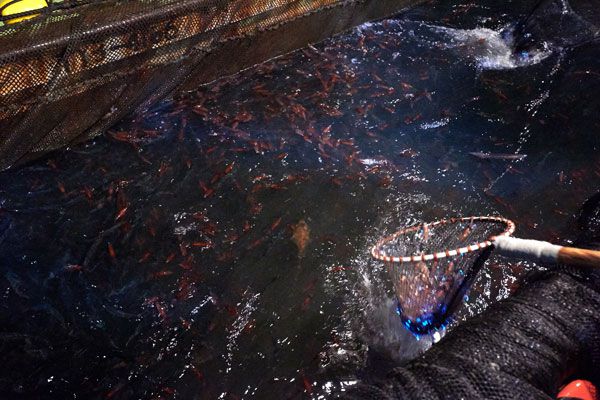
As the boats near the point of the fixed nets, the fishermen line up and start hauling them in. The nets are suffused with a shimmering blue glow, tempered by the sardines darting to and fro.
A smaller net with a handle, called a scoop net, is used to carefully land the delicate firefly squid on the deck of the boat. The squirming mass of squid is transferred to a container, where it continues to glow for a short while.
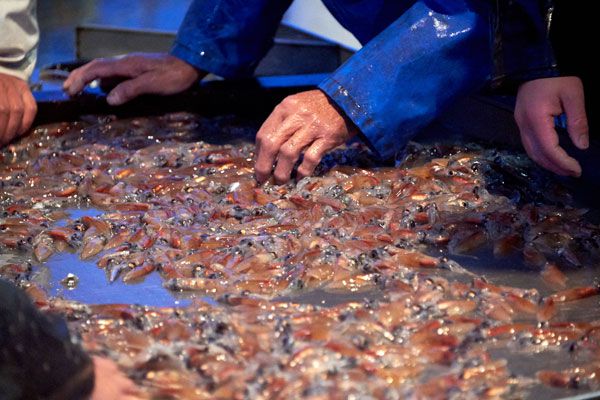
“Not much today,” says a disappointed skipper Kazuhito Mizuhashi. “The size of the catch varies so much from day to day.”
The wind begins to rise, making the seas a little choppy, and the firefly squid quickly retreat to the ocean depths. The fishermen sort through the catch on the boat, then return to port just as the sun emerges over the horizon at around five o’clock. The catch is auctioned off, then boiled immediately for shipment. Firefly squid do not keep for long, so speed is of the essence.
Sampling the catch of the day
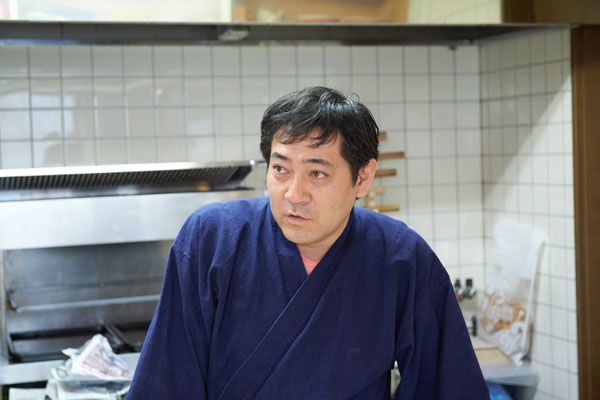
Five minutes by car from the port of Namerikawa is a homely restaurant called Kappo-araki where you can enjoy deliciously fresh firefly squid and other local seafood delicacies cooked to perfection.
“We don’t use any colorings, flavorings or preservatives,” enthuses owner Kiyofumi Araki. “We use only locally sourced soy sauce and sake products to make our signature pickled firefly squid, as well as ponzu (citrus vinegar) and gari (pickled ginger in sweet vinegar).”
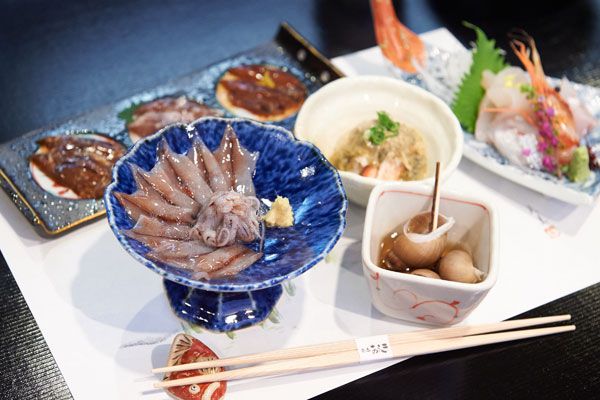
Kappo-araki serves a wonderful home-style sashimi dish of firefly squid arranged artfully on a platter (after carefully removing the entrails, of course). An unusual variant, said to be particularly popular among the fishermen, is ryugu somen, where the tentacles are dipped in soy sauce steeped in ginger to produce an incredible flavor sensation with just the right amount of bite.
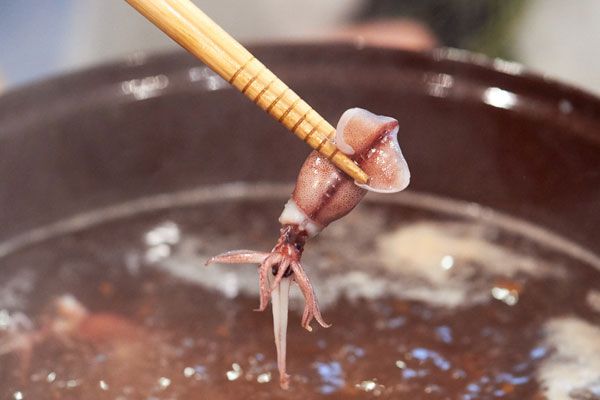
Araki’s recommendation is the firefly squid kama-age hotpot, where the squid are boiled in a broth of sake and kombu seaweed until just tender, then dipped in vinegared miso paste. The simplicity of this dish accentuates the fresh taste.
A trip to Toyama is certainly an experience to remember. First you get to marvel at the luminescent blue glow of the firefly squid in the bay, and then you can sample the most delicious fresh seafood produce.
Firefly squid in Namerikawa
Source:Kappo-araki owner Kiyofumi Araki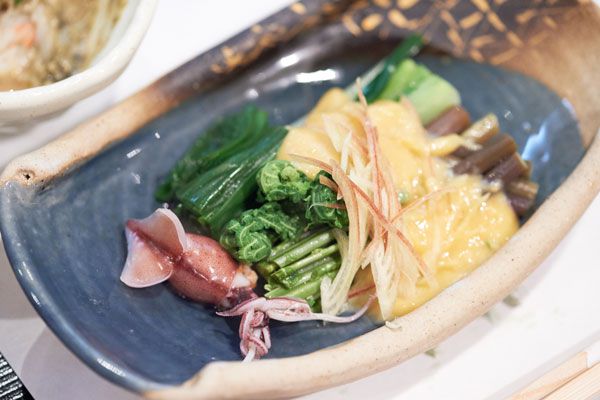
Peak Season
March to June. Best eaten during the April spawning season
How to enjoy them
A simple hotpot dish with vinegared miso paste is the best way to enjoy freshly caught firefly squid.
Firefly squid museum
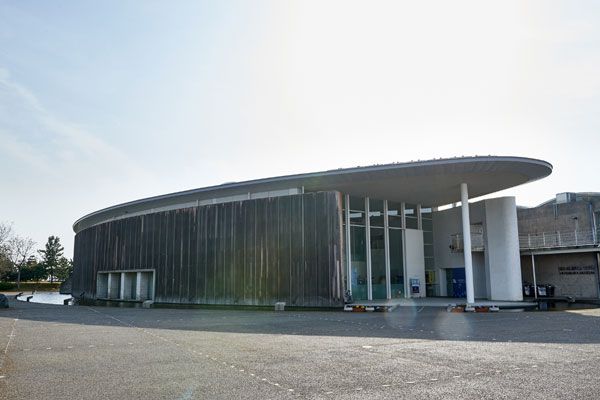
There is still much we do not know about the life and times of the firefly squid. This enigmatic creature of the sea harbors many more mysteries that are yet to be revealed. At the Firefly Squid Museum, located right next to the port area at Namerikawa, you can learn more about the life cycle of this mysterious creature and its Toyama Bay habitat. There is spectacular Full Hi Vision video on the big screen, as well as live demonstrations of firefly squid from mid to late March through to the end of May every year
| Address | 410 Nakagawara, Namerikawa-shi, Toyama prefecture |
|---|---|
| TEL | 076-476-9300 |
| Open | 9:00-17:00 (Last entry 30 minutes before closing time) |
| Closed | ・ Tuesdays from June 1 to March 19 (or Wednesday if Tuesday is a public holiday) ・End of year holiday period ・ Monday to Wednesday of last week in January |
| URL | http://hotaruikamuseum.com/museum |

